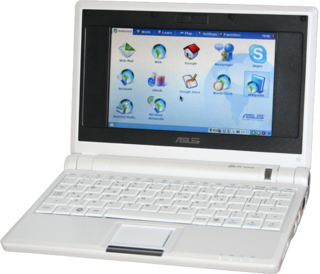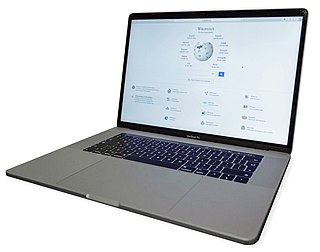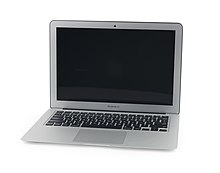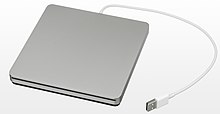
A netbook is a small and inexpensive laptop designed primarily as a means of accessing the Internet. Netbooks were sold from 2007 until around 2013, when the widespread advent of smartphones and tablets eclipsed their popularity.

The MacBook Pro is a line of Mac laptop computers developed and manufactured by Apple. Introduced in January 2006, it is the higher-end lineup in the MacBook family, sitting above the less expensive MacBook Air. It is currently sold with 14-inch and 16-inch screens, all using Apple silicon M-series chips.

The MacBook is a line of Mac laptops sold by Apple Inc. between May 2006 and February 2012. It replaced the iBook series of notebooks as a part of Apple's transition from PowerPC to Intel processors. Positioned as the low end of the MacBook family, below the premium ultra-portable MacBook Air and the performance-oriented MacBook Pro, the MacBook was aimed at the consumer and education markets. It became the best-selling Mac in Apple's history. For five months in 2008, it was the best-selling laptop of any brand in US retail stores.

Subnotebook, also called ultraportable, superportable, or mini notebook, was a marketing term for laptop computers that are smaller and lighter than a typical notebook-sized laptop.

The iMac is a series of all-in-one desktop computers designed, manufactured, and sold by Apple Inc. Between 2006 and 2022, the iMac series used chipsets based on Intel architecture. While sold, it was one of three desktop computers in the Mac lineup, serving as an all-in-one alternative to the Mac Mini, and sat below the performance range Mac Pro. It was sold alongside the Xeon-based iMac Pro from 2017 to 2021.

The ASUS Eee PC is a netbook computer line from Asus, and a part of the ASUS Eee product family. At the time of its introduction in late 2007, it was noted for its combination of a lightweight, Linux-based operating system, solid-state drive (SSD), and relatively low cost. Newer models added the options of Microsoft Windows operating system and rotating media hard disk drives (HDD), and initially retailed for up to 500 euros.

The MacBook Air is a line of laptop computers developed and manufactured by Apple since 2008. It features a thin, light structure in a machined aluminum case and currently either a 13-inch or 15-inch screen. The MacBook Air's lower prices relative to the larger, higher performance MacBook Pro have made it Apple's entry-level notebook since the discontinuation of the original MacBook line in 2011.

MacBook is a brand of Mac notebook computers designed and marketed by Apple that use Apple's macOS operating system since 2006. The MacBook brand replaced the PowerBook and iBook brands during the Mac transition to Intel processors, announced in 2005. The current lineup consists of the MacBook Air (2008–present) and the MacBook Pro (2006–present). Two different lines simply named "MacBook" existed from 2006 to 2012 and 2015 to 2019. The MacBook brand was the "world's top-selling line of premium laptops" as of 2015.

The iMac is a line of all-in-one Mac desktop computers designed and built by Apple Inc. It has been the primary part of Apple's consumer desktop offerings since its debut in August 1998, and has evolved through seven distinct forms.
Thunderbolt is the brand name of a hardware interface for the connection of external peripherals to a computer. It was developed by Intel in collaboration with Apple. It was initially marketed under the name Light Peak, and first sold as part of an end-user product on 24 February 2011.

Retina display is a branded series of IPS LCDs and OLED displays by Apple Inc. that have a higher pixel density than traditional displays. Apple has registered the term "Retina" as a trademark with regard to computers and mobile devices with the United States Patent and Trademark Office and Canadian Intellectual Property Office. The applications were approved in 2012 and 2014 respectively. The Canadian application cited a 2010 application in Jamaica.

Ultrabook is a marketing term, originated and trademarked by Intel, for a category of high-end laptop computers.

The Apple Thunderbolt Display is a 27-inch flat panel computer monitor developed and sold by Apple Inc. from July 2011 to June 2016. Originally priced at $999, it replaced the 27-inch Apple LED Cinema Display. The Thunderbolt Display switched from Mini DisplayPort and USB connectors to a single Thunderbolt connector for data and DisplayPort. The Thunderbolt Display also added a Gigabit Ethernet port and FireWire 800 port. It is not compatible with computers without Thunderbolt, including, but not limited to desktop PCs without a Thunderbolt port; Macs released before 2011; the 2012 Mac Pro; and the single USB-C Retina MacBook. Devices with Thunderbolt 3 can use the display with an adapter.

The 12-inch MacBook is a discontinued Mac laptop made by Apple Inc., which sat between the MacBook Air and MacBook Pro in Apple's laptop lineup.

Apple M1 is a series of ARM-based system-on-a-chip (SoC) designed by Apple Inc. as a central processing unit (CPU) and graphics processing unit (GPU) for its Mac desktops and notebooks, and the iPad Pro and iPad Air tablets. The M1 chip initiated Apple's third change to the instruction set architecture used by Macintosh computers, switching from Intel to Apple silicon 14 years after they were switched from PowerPC to Intel, and 26 years after the transition from the original Motorola 68000 series to PowerPC. At the time of introduction in 2020, Apple said that the M1 had the world's fastest CPU core "in low power silicon" and the world's best CPU performance per watt. Its successor, Apple M2, was announced on June 6, 2022, at Worldwide Developers Conference (WWDC).
The MacBook Air is a line of Mac laptops made by Apple Inc. In 2020, Apple stopped using Intel processors in the Air and switched to using their own Apple silicon M-series chips. In the current product line, the MacBook Air is Apple's entry-level laptop, situated below the performance range MacBook Pro, and is currently sold with 13-inch and 15-inch screens.

The fifth-generation iPad Pro, colloquially known as the M1iPad Pro, is a line of iPad tablet computers developed and marketed by Apple Inc. It was announced on April 20, 2021, and was available in 11-inch (28 cm) and 12.9-inch (33 cm) screen size options, which are the same as its predecessor, the iPad Pro. Preorders began on April 30, 2021, and the product was released worldwide on May 21, 2021. It comes in two colors: Silver and Space Gray.

The MacBook Pro with Apple silicon is a line of Mac notebook computers first introduced in November 2020 by Apple Inc. It is the higher-end model of the MacBook family, sitting above the consumer-focused MacBook Air, and is currently sold with 14-inch and 16-inch screens. All models use Apple-designed M-series systems on a chip.

The Intel-based MacBook Pro is a discontinued line of Macintosh notebook computers sold by Apple Inc. from 2006 to 2021. It was the higher-end model of the MacBook family, sitting above the consumer-focused MacBook Air, and was sold with 13-inch to 17-inch screens.























